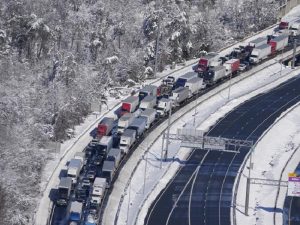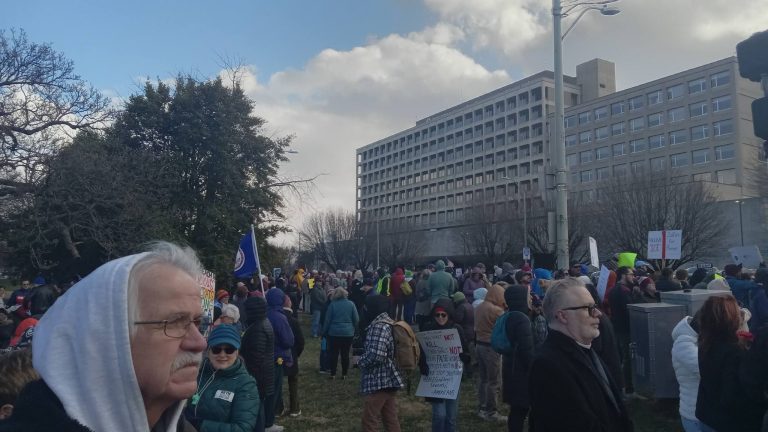
RICHMOND, Va. (AP) — Virginia state agencies collectively “lost situational awareness” and failed to keep up with growing gridlock during a January snowstorm that stranded hundreds of motorists along Interstate 95, a state-commissioned report released Friday said.
While the 41-page report offered suggestions for improving future emergency responses, it did not ascribe blame to any single person or agency. It noted first responders faced unusually heavy snowfall, busier-than-normal traffic and COVID-19-related staffing shortages — all while dealing with a highway corridor notorious for congestion in the best of circumstances.
State officials, including leaders of the Virginia Department of Transportation, vowed to thoroughly review the report and its recommendations.
“VDOT’s top priority is and always will be the safety of the traveling public, and as we learn from each event, this report highlighted key areas for us to refine in our winter-weather operations,” Virginia Commissioner of Highways Stephen Brich said.
No deaths or injuries were reported from the gridlock near the nation’s capital. But the monster logjams fed outrage among motorists, some of them stranded overnight Monday, Jan. 3, into Tuesday, Jan. 4, pleading on social media for help.
The report included a detailed timeline. It noted plowing began as snow began accumulating, but earlier rain meant roads couldn’t be pretreated.
Traffic accidents began just before 4 a.m. Monday and conditions worsened for hours, with traffic bogging down in heavy afternoon congestion, the report said. Snowfall then intensified, with reports of three inches an hour falling in the Fredericksburg area south of Washington, D.C. Snowplows struggled to keep up.
The queue of traffic continued to build and by 3 a.m. that Tuesday, numerous clusters of disabled cars and tractor-trailers were scattered along a 40-mile (65-kilometer) stretch of I-95 both ways, the report said.
With alternate routes impassable, problems mounted and “state agencies collectively lost situational awareness and could not verify the extent and locations of the blockages,” according to the report.
It said that was partly due to numerous technological challenges, including a traffic camera failure during widespread power outages; a power outage and ensuing generator issue at a Virginia State Police communications center; severe communications issues with inoperable cell towers; and a system failure of the VDOT real-time traffic information service.
Information also flooded in from social media posts but responding agencies didn’t have a plan for using those “non-traditional data sources” to form an operational picture, the report said, adding that “information was not conveyed to agency leadership in real time.”
Meanwhile, some VDOT districts experienced field staff shortages because of COVID-19, and Virginia State Police had “widespread staffing issues” before the storm, according to the report.
Adding to the woes, passenger traffic was higher than normal because of recent holidays and a raft of flight cancellations, the report said. And “just-in-time” trucking was up since 2019, partly due to supply chain issues.
The report addressed questions frequently raised in the immediate aftermath of the snowstorm, including why then-Gov. Ralph Northam, a Democrat, did not activate the Virginia National Guard.
The report said state officials explored the possibility but noted, as Northam did at the time, that the Guard is not a “quick reaction force.”
The report said the Guard, even if it had been activated, would have had little to no impact on a “situation already in progress.”
The report also addressed questions raised about why more direct assistance to the stranded motorists was not provided. State officials considering that concluded the best strategy was to stay focused on clearing the highway, it said.
Responding to the report, Republican Gov. Glenn Youngkin and members of his administration took critical aim at Northam and his office.
Youngkin said in a news release that the report showed “the previous administration’s leadership did not properly prepare or communicate.”
In a letter to Youngkin, Transportation Secretary W. Sheppard Miller III and Public Safety Secretary Robert Mosier claimed there was “almost no apparent involvement by the Governor or his senior staff.”
The secretaries wrote it appeared neither Northam nor his staff considered an emergency declaration. Emails obtained by The Associated Press in the aftermath of the gridlock showed that was not the case and that consideration was given as to whether one was appropriate.
Northam’s name was mentioned only once in the report, which did not list anyone from his office among those interviewed. The report did not explain the interview selections.
The report was produced by CNA, a nonprofit research and analysis organization that has conducted similar work for the U.S. Navy and local, state and federal government agencies. It said it drew from documents including situation reports, real-time planning documents, news articles, social media, interviews and other sources.
The report also included an admonition to motorists.
“Additionally, the public bears some responsibility to stay informed about road conditions and traffic during snowstorms, and should implement an informed decision-making process before choosing to take to the roadways,” it said.



